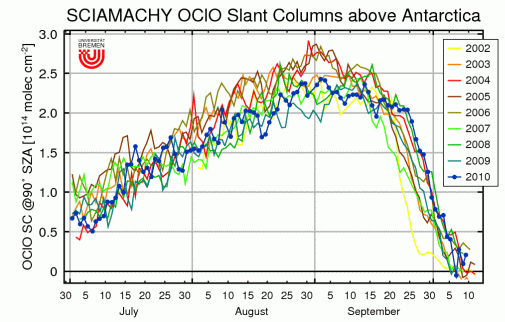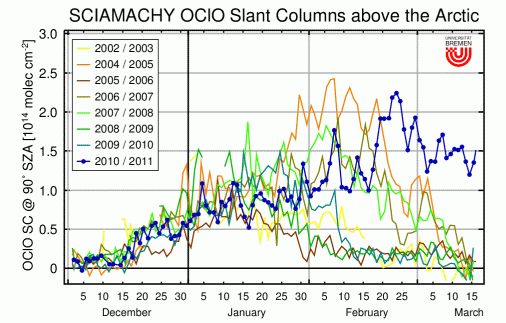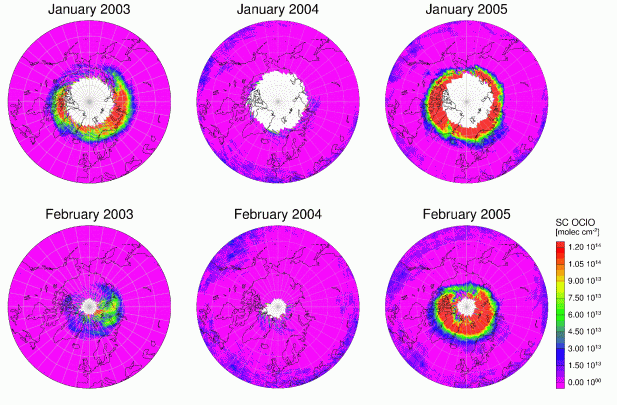
OClO from SCIAMACHY
measurements
 Introduction:
Introduction:
Each year, Ozone levels in the Antarctic stratosphere drop in winter and spring, leading to the the well known Ozone Hole over the Antarctic continent which covers most of the Polar Vortex area in August and September (see e.g. GAW). Similar ozone loss is observed in the northern hemisphere in cold years, but as result of the higher temperatures and the less stable meteorology, the situation is more variable. Most of the ozone loss is due to catalytic reactions of ClO and BrO after heterogeneous activation of the chlorine reservoirs (HCl and ClONO2) on polar stratospheric clouds (PSC). The degree of chlorine activation can be monitored by observing OClO, a molecule which is thought to be formed mainly by reaction of ClO and BrO. As BrO amounts do not vary as much, OClO columns are in first approximation proportional to ClO concentrations and therefore an indicator of chlorine activation.
Interpretation of satellite OClO maps is complicated by the rapid photochemistry of OClO and the systematic variation in local solar zenith angle (SZA) which results from the sun-synchronous orbit of ENVISAT. There are two different approaches to using these data: either comparison of data sets taken under comparable boundary conditions (averages over the same time period in different years or averages over a constant SZA interval such as 89° - 91° SZA) or use of a chemical model. While the latter is more appropriate for detailed analysis, the first option provides quick information on changes between years.
In the figure above, the evolution of the OClO slant columns at 90° SZA is shown for the Southern Hemisphere. SCIAMACHY nadir measurements started in August 2002. The figure shows that overall, chlorine activation is quite similar between the years with the notable exception of 2002 when an unusually weak and non-circular polar vortex led to lower activation, stronger fluctuations and an early deactivation. The variations observed in July and September are related to displacements of the vortex which bring air with more or less chlorine to the latitude range probed by the SCIAMACHY 90° SZA measurements.
As a second example, OClO slant columns derived from SCIAMACHY measurements for different years in the northern hemisphere are shown in the figure above. Clearly, chlorine activation was very different in these years, mainly as result of differences in meteorology and therefore PSC occurrence.
 Data:
Data:
OClO Slant columns from SCIAMACHY nadir measurements are available from August 2002 onwards. Currently, the analysis is based on a rather limited set of both uncalibrated and calibrated data that have been released by ESA, and therefore has to be considered as preliminary.
When comparing SCIAMACHY and GOME OClO columns from the GOME NRT pages, it must be borne in mind that the SZA at the time of overpass differs between the two instruments and therefore also the photochemical situation sampled.
Images of daily, monthly, and annual averages of OClO slant columns can be viewed on our SCIAMACHY data browser page.
A short description of the algorithm used for the OClO data product can be found in the OClO Algorithm Description.
If you have any requests, please contact Andreas Richter.
 References:
References:
- Oetjen, H., Wittrock, F., Richter, A., Chipperfield, M. P., Medeke, T., Sheode, N., Sinnhuber, B.-M., Sinnhuber, M., and Burrows, J. P.: Evaluation of stratospheric chlorine chemistry for the Arctic spring 2005 using modelled and measured OClO column densities, Atmos. Chem. Phys., 11, 689-703, doi:10.5194/acp-11-689-2011, 2011
- Long-term Monitoring of OClO and NO2 from Space, A. Richter et al., Regional SPARC Science Workshop, Bremen, Germany, September 17 - 18, 2007
-
Comparison of Modelled and Measured Chlorine Dioxide Slant Columns for the Arctic Winter 2004/2005, H. Oetjen et al., Poster presentation at the DPG Frühjahrstagung, March 2006
-
Richter, A., F. Wittrock, M. Weber, S. Beirle, S. Kühl, U. Platt, T. Wagner, W. Wilms-Grabe, and J. P. Burrows, GOME observations of stratospheric trace gas distributions during the splitting vortex event in the Antarctic winter 2002 Part I: Measurements, J. Atmos. Sci., 62 (3), 778-785, 2005
 Links:
Links:
-
GOME OClO columns can be found on the GOME NRT pages.
-
More information on SCIAMACHY can be found here.
-
Stratospheric OClO profiles retrieved from SCIAMACHY limb measurements can be found on the IUP Bremen SCIAMACHY data archive.
-
Many SCIAMACHY related links can be found on the German SCIAMACHY page.
-
For information on the satellite and other ENVISAT instruments check the ESA ENVISAT page.
 Contact:
Contact:
If you are interested in more information or SCIAMACHY OClO data, please contact Andreas Richter.


